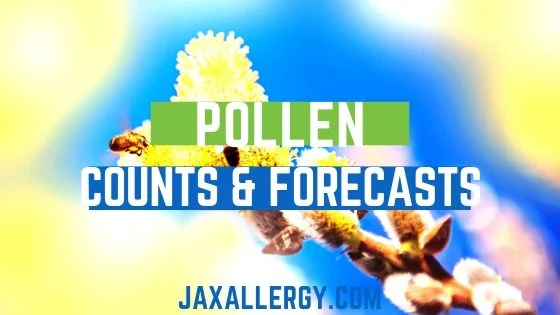Understanding Pollen Counts: Pollen Allergy Forecasts FAQs

Living in the Jacksonville area, you know that pollen and other allergy-causing factors can get very bad certain times of the year. In fact, tree pollen is one of the worst and most common allergens we have here in Northeast Florida. Our area produces heavy levels of tree pollen starting in January. This is much earlier than the usual springtime pollen production seen in most other areas of the country. Many people gauge pollen levels by visual factors in the outside environment–like, the layer of yellow sometimes covering our cars. At that point, your allergies have more than likely already kicked into full gear and you can’t stop sneezing.
But learning about, understanding, and paying attention to pollen counts and pollen forecasts can prove to be invaluable in fighting allergies. More importantly, checking the local pollen count can be helpful in preventing the allergic discomfort that the ‘layer of yellow’ causes. Let’s take a look at some of the most frequently asked questions regarding pollen counts and pollen allergy forecasts.
What is a pollen allergy forecast?
Pollen allergy forecasts are predictions of what the pollen levels will be in the future, very much like a traditional weather forecast. These forecasts are based on a variety of seasonal and environmental factors that include past and current pollen counts, weather conditions, and temperatures. This information helps determine exactly how much pollen an allergy sufferer is likely to be exposed to for up to four days in the future.
Oftentimes, understanding a pollen forecast has more value for allergy sufferers compared to just a pollen count. This is because you can use this information to plan your day or whether or not to take medication.
What are pollen counts?
Simply put, a pollen count is a measurement of how much pollen is currently present in the air in a particular area. Pollen counts can be specific to one type of pollen, like ragweed, or it can represent the concentration of all the pollen combined. The count is given in grains of pollen per cubic meter within a 24 hour period.
The difference between a pollen count and a pollen allergy forecast is that pollen counts show what is in the air currently or for several days prior. While a pollen allergy forecast will show what is going to happen with pollen levels later today or over the next several days.
Pollen counts are used by everyone from allergy sufferers themselves to allergy researchers. Pharmaceutical companies use the information in their drug research to produce new relief-providing solutions that work with evolving environmental factors. Pollen counts are vital to allergy researchers and doctors who find new trends between the symptoms themselves and allergy-inducing conditions.
Who invented the pollen count?
The pollen count was invented in by Dr. William Franklin. Franklin is a famed British allergist, often referred to as the “Grandfather of Allergy”, whose achievements include not only the popularization of pollen counts but also the prediction of increased levels of allergy to penicillin. Initially, he aimed to provide the patients he saw in London with as much information about pollens, such as the levels of pollen on any given day, and the times of the year when levels would tend to be at their highest. His methodology later turned into what has been used for decades to establish pollen levels across the globe.
At the age of 105 now, he is still a practicing physician and allergy researcher. He also continues to publish medically-renowned research papers, including “100 Years Of Allergen Immunotherapy” that he authored at the age of 100.
What is PPM in pollen count?
A pollen count is gathered by determining how much pollen is present in the air over a 24 hour period. This is expressed in PPM, or pollen per cubic meter.
How exactly are pollen counts calculated?
Pollen counts are calculated using an air-sampling device. The particular devices used in today’s testing is usually performed with either the Burkard Sampler or the Rotorod Sampler from IQVIA, a health research company. These device are placed on a rooftop and has a transparent sticky surface. Particles in the air stick to the surface of the device during a full 24 hour period. This sample is then examined under a microscope and the pollen grains are identified and counted. Resulting in an overall pollen count and pollen count by allergen type. Pollen travels easily over long distances. So, at each of the testing sites, these counts are usually considered the applicable count and data for that entire city.
How long does it take to get a pollen sample?
Collecting a pollen sample over a 24 hour period using a device like the Rotorod Sampler may sound simple and easy. But, accurate pollen sampling can be very time-consuming and get expensive quickly. It actually requires hours of work as well as significant experience and training.
What is the range for pollen count?
A pollen count is typically measured on a scale of 0-12. These counts factor in the amount of pollen an allergy sufferer will be exposed to during a given day.
What pollen count is considered high?
Pollen count levels are determined by ranges on the overall scale of 0-12. Usually, a High level is considered to be from 9.7-12.0, High-Medium is 7.3-9.6, and Medium is 4.9-7.2.
What is considered a low pollen count?
In following with the ranges from High to Medium, a low pollen count is considered to be from 0-2.4 and Low-Medium is 2.5-4.8.
Who is responsible for the pollen counts?
Pollen counts are conducted and researched by government agencies, allergists, private physicians, educational institutions, commercial research companies, and pharmaceutical companies.
Is pollen worse in the morning or evening?
On most days, midday is going to be the peak of pollen counts. Pollen levels usually rise during the morning, reach their highest levels midday, and then gradually fall into the evening.
This means that the lowest pollen counts are usually going to be before well before dawn, dusk and the evening. Of course, certain weather factors play a huge role in pollen levels. So, some days may see higher levels throughout most of the day while other weather patterns can keep levels lower throughout the day.
What causes pollen levels to rise?
The wind is the number one factor in stirring up pollen into the air. Essentially it shakes the pollen from trees, plants, and flowers making it airborne. That is why, oftentimes, dry windy weather will cause the highest pollen levels. Usually, rain will dramatically lower airborne pollen any time of day as it makes it heavier and keeps it out of the air.
There are some situations where rainy weather can make things worse. Thunderstorms or hurricanes can actually make matters worse for allergy sufferers. Pollen grains can be carried by the heavy winds produced in thunderstorms and can easily be ruptured. This causes an increased allergic reaction during thunderstorms as well as a phenomenon called thunderstorm asthma. If the forecast is calling for thunderstorms, your best bet as an allergy sufferer is to stay indoors as much as possible. The quickly changing weather leading up to storms seems to significantly increase pollen levels in the air.
Depending on the time of year, normal rain can cause more problems. When rain happens in the late fall or winter this will increase tree pollination amounts, causing elevated pollen levels. Also, higher levels of rain in the spring makes grass and flowers grow faster, producing more unwanted pollen.
What part of the year is pollen allergy forecasts at their highest levels?
Usually, early springtime throughout the country is when pollen levels are at their worst as new trees, flowers, and grass are all growing and blooming. This time of the year is usually referred to as pollen season. But, for the Northeast Florida area, which sees a usual early start in late January or February, the 2019 pollen season came even earlier and actually started in early-mid January. For the Jacksonville area, the most severe time of pollen season normally runs from late February to early May. Due to our climate, allergy sufferers battle blooming plants and trees all the way through the fall.
Jacksonville ranked #48 amongst the worst cities for spring allergies in 2019. That is why understanding pollen counts and pollen allergy forecasts can prove to be invaluable to local allergy sufferers.
Since the turn of the 20th century, pollen counting and forecasting have been recognized as a very important measurement. These counts have significantly improved the knowledge of the role plant pollen plays in causing allergies that millions of people suffer from. Because of this, pollen counts have become a powerful tool, much like accurate weather forecasts, in day to day health problem solving for many individuals.
Our board-certified allergists at Allergy & Asthma Specialists of North Florida can help you make sense of pollen counts and forecasts as it pertains to your symptoms. Contact us today for more information and to schedule an appointment. Don’t let your allergies keep you indoors! You don’t have to suffer, we’re here to help.
